Nursing Report: Stimulant Use, Academic Performance in Students
VerifiedAdded on 2020/04/21
|9
|2180
|104
Report
AI Summary
This nursing report critically analyzes two peer-reviewed research papers to investigate the relationship between stimulant use and academic performance in university students, addressing the PICO question: "Do stimulants increase academic performance in university students?" The report examines the methodologies, findings, strengths, and weaknesses of each study, including a qualitative study exploring the context of stimulant use and a quantitative study examining the relationship between non-medical stimulant use, executive functioning, and academic outcomes. It discusses the challenges of applying research findings to practice, specifically in the case of a student named Wasim, and evaluates the alignment of the research studies with the PICO question. The report concludes that more research is needed to determine the efficacy of stimulants for academic purposes, emphasizing the importance of evidence-based practice in nursing and the need for robust research methodologies. The report also highlights the multifaceted aspects of stimulant use by students and provides insights that can be considered for application to real-life contexts under suitable conditions, while cautioning against applying the insights drawn from the articles into practice without further research.
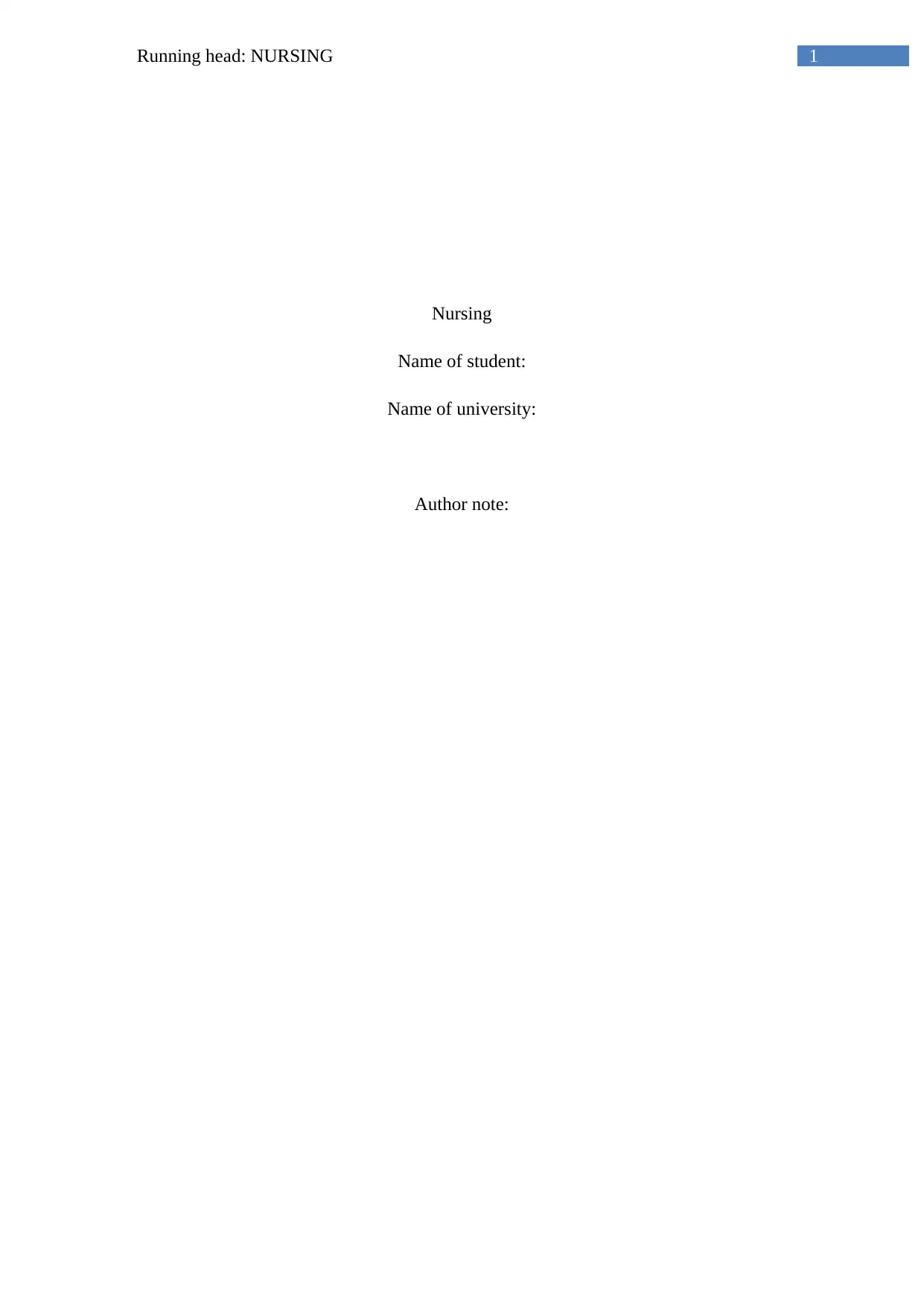
1Running head: NURSING
Nursing
Name of student:
Name of university:
Author note:
Nursing
Name of student:
Name of university:
Author note:
Paraphrase This Document
Need a fresh take? Get an instant paraphrase of this document with our AI Paraphraser
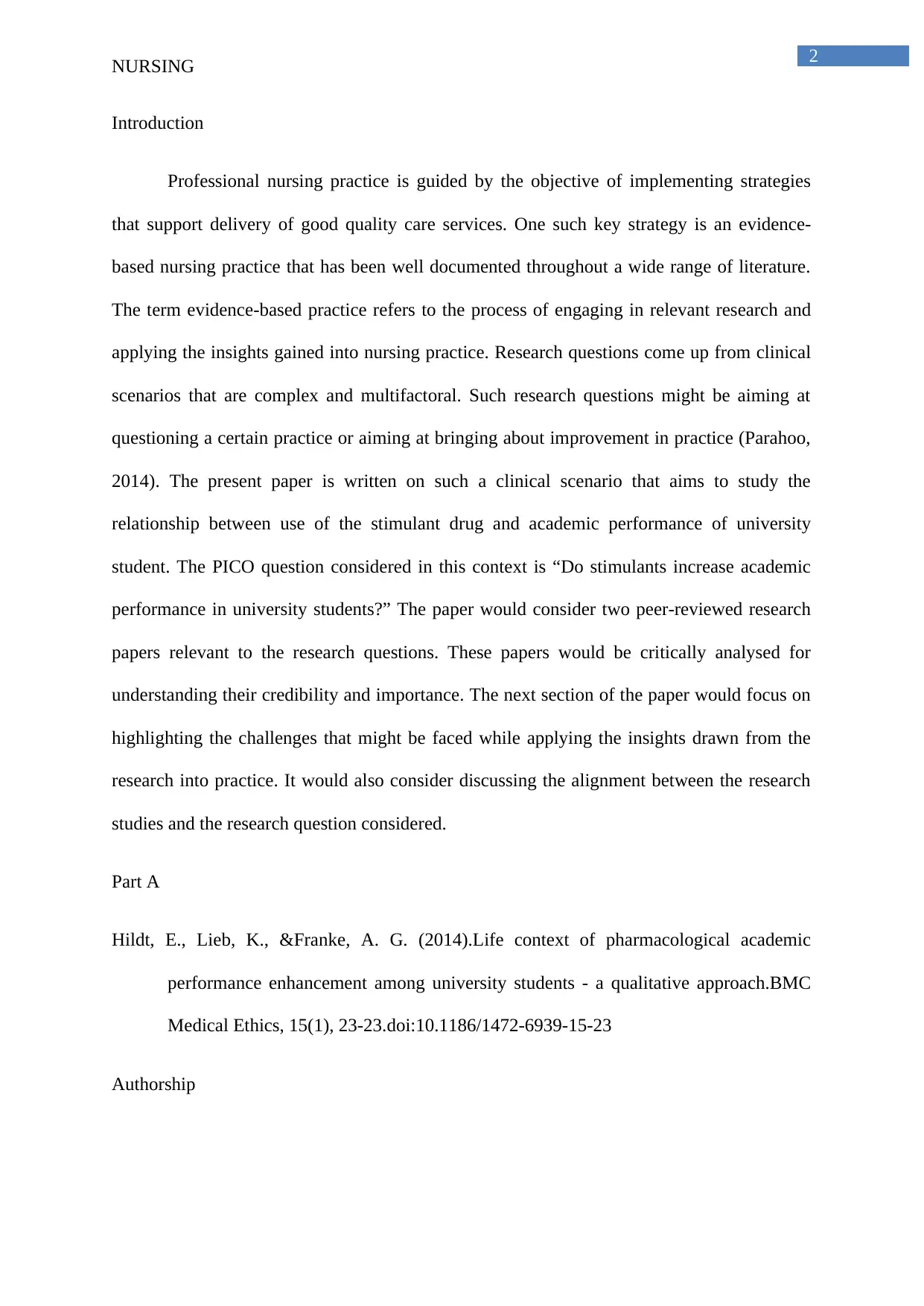
2
NURSING
Introduction
Professional nursing practice is guided by the objective of implementing strategies
that support delivery of good quality care services. One such key strategy is an evidence-
based nursing practice that has been well documented throughout a wide range of literature.
The term evidence-based practice refers to the process of engaging in relevant research and
applying the insights gained into nursing practice. Research questions come up from clinical
scenarios that are complex and multifactoral. Such research questions might be aiming at
questioning a certain practice or aiming at bringing about improvement in practice (Parahoo,
2014). The present paper is written on such a clinical scenario that aims to study the
relationship between use of the stimulant drug and academic performance of university
student. The PICO question considered in this context is “Do stimulants increase academic
performance in university students?” The paper would consider two peer-reviewed research
papers relevant to the research questions. These papers would be critically analysed for
understanding their credibility and importance. The next section of the paper would focus on
highlighting the challenges that might be faced while applying the insights drawn from the
research into practice. It would also consider discussing the alignment between the research
studies and the research question considered.
Part A
Hildt, E., Lieb, K., &Franke, A. G. (2014).Life context of pharmacological academic
performance enhancement among university students - a qualitative approach.BMC
Medical Ethics, 15(1), 23-23.doi:10.1186/1472-6939-15-23
Authorship
NURSING
Introduction
Professional nursing practice is guided by the objective of implementing strategies
that support delivery of good quality care services. One such key strategy is an evidence-
based nursing practice that has been well documented throughout a wide range of literature.
The term evidence-based practice refers to the process of engaging in relevant research and
applying the insights gained into nursing practice. Research questions come up from clinical
scenarios that are complex and multifactoral. Such research questions might be aiming at
questioning a certain practice or aiming at bringing about improvement in practice (Parahoo,
2014). The present paper is written on such a clinical scenario that aims to study the
relationship between use of the stimulant drug and academic performance of university
student. The PICO question considered in this context is “Do stimulants increase academic
performance in university students?” The paper would consider two peer-reviewed research
papers relevant to the research questions. These papers would be critically analysed for
understanding their credibility and importance. The next section of the paper would focus on
highlighting the challenges that might be faced while applying the insights drawn from the
research into practice. It would also consider discussing the alignment between the research
studies and the research question considered.
Part A
Hildt, E., Lieb, K., &Franke, A. G. (2014).Life context of pharmacological academic
performance enhancement among university students - a qualitative approach.BMC
Medical Ethics, 15(1), 23-23.doi:10.1186/1472-6939-15-23
Authorship
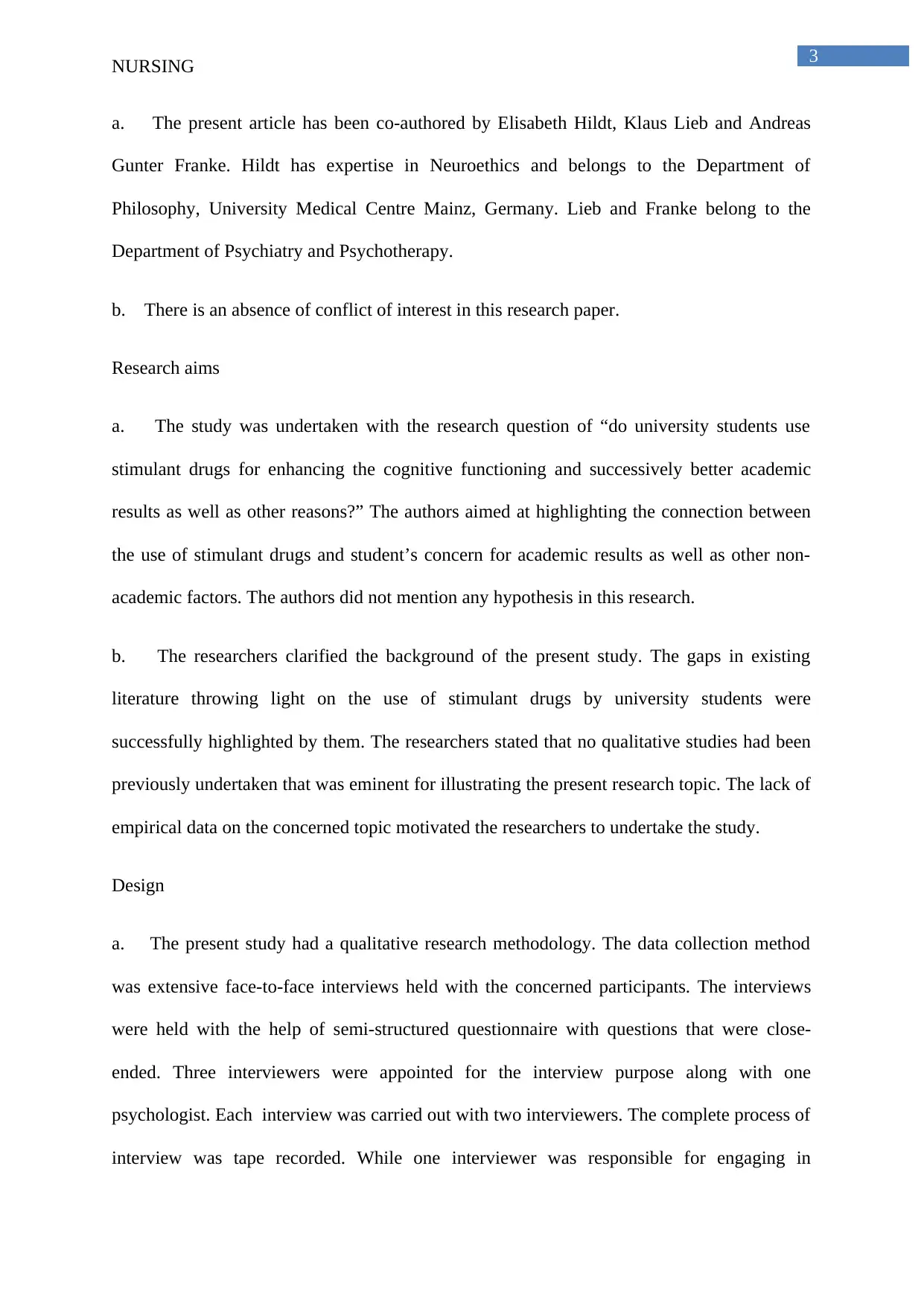
3
NURSING
a. The present article has been co-authored by Elisabeth Hildt, Klaus Lieb and Andreas
Gunter Franke. Hildt has expertise in Neuroethics and belongs to the Department of
Philosophy, University Medical Centre Mainz, Germany. Lieb and Franke belong to the
Department of Psychiatry and Psychotherapy.
b. There is an absence of conflict of interest in this research paper.
Research aims
a. The study was undertaken with the research question of “do university students use
stimulant drugs for enhancing the cognitive functioning and successively better academic
results as well as other reasons?” The authors aimed at highlighting the connection between
the use of stimulant drugs and student’s concern for academic results as well as other non-
academic factors. The authors did not mention any hypothesis in this research.
b. The researchers clarified the background of the present study. The gaps in existing
literature throwing light on the use of stimulant drugs by university students were
successfully highlighted by them. The researchers stated that no qualitative studies had been
previously undertaken that was eminent for illustrating the present research topic. The lack of
empirical data on the concerned topic motivated the researchers to undertake the study.
Design
a. The present study had a qualitative research methodology. The data collection method
was extensive face-to-face interviews held with the concerned participants. The interviews
were held with the help of semi-structured questionnaire with questions that were close-
ended. Three interviewers were appointed for the interview purpose along with one
psychologist. Each interview was carried out with two interviewers. The complete process of
interview was tape recorded. While one interviewer was responsible for engaging in
NURSING
a. The present article has been co-authored by Elisabeth Hildt, Klaus Lieb and Andreas
Gunter Franke. Hildt has expertise in Neuroethics and belongs to the Department of
Philosophy, University Medical Centre Mainz, Germany. Lieb and Franke belong to the
Department of Psychiatry and Psychotherapy.
b. There is an absence of conflict of interest in this research paper.
Research aims
a. The study was undertaken with the research question of “do university students use
stimulant drugs for enhancing the cognitive functioning and successively better academic
results as well as other reasons?” The authors aimed at highlighting the connection between
the use of stimulant drugs and student’s concern for academic results as well as other non-
academic factors. The authors did not mention any hypothesis in this research.
b. The researchers clarified the background of the present study. The gaps in existing
literature throwing light on the use of stimulant drugs by university students were
successfully highlighted by them. The researchers stated that no qualitative studies had been
previously undertaken that was eminent for illustrating the present research topic. The lack of
empirical data on the concerned topic motivated the researchers to undertake the study.
Design
a. The present study had a qualitative research methodology. The data collection method
was extensive face-to-face interviews held with the concerned participants. The interviews
were held with the help of semi-structured questionnaire with questions that were close-
ended. Three interviewers were appointed for the interview purpose along with one
psychologist. Each interview was carried out with two interviewers. The complete process of
interview was tape recorded. While one interviewer was responsible for engaging in
⊘ This is a preview!⊘
Do you want full access?
Subscribe today to unlock all pages.

Trusted by 1+ million students worldwide
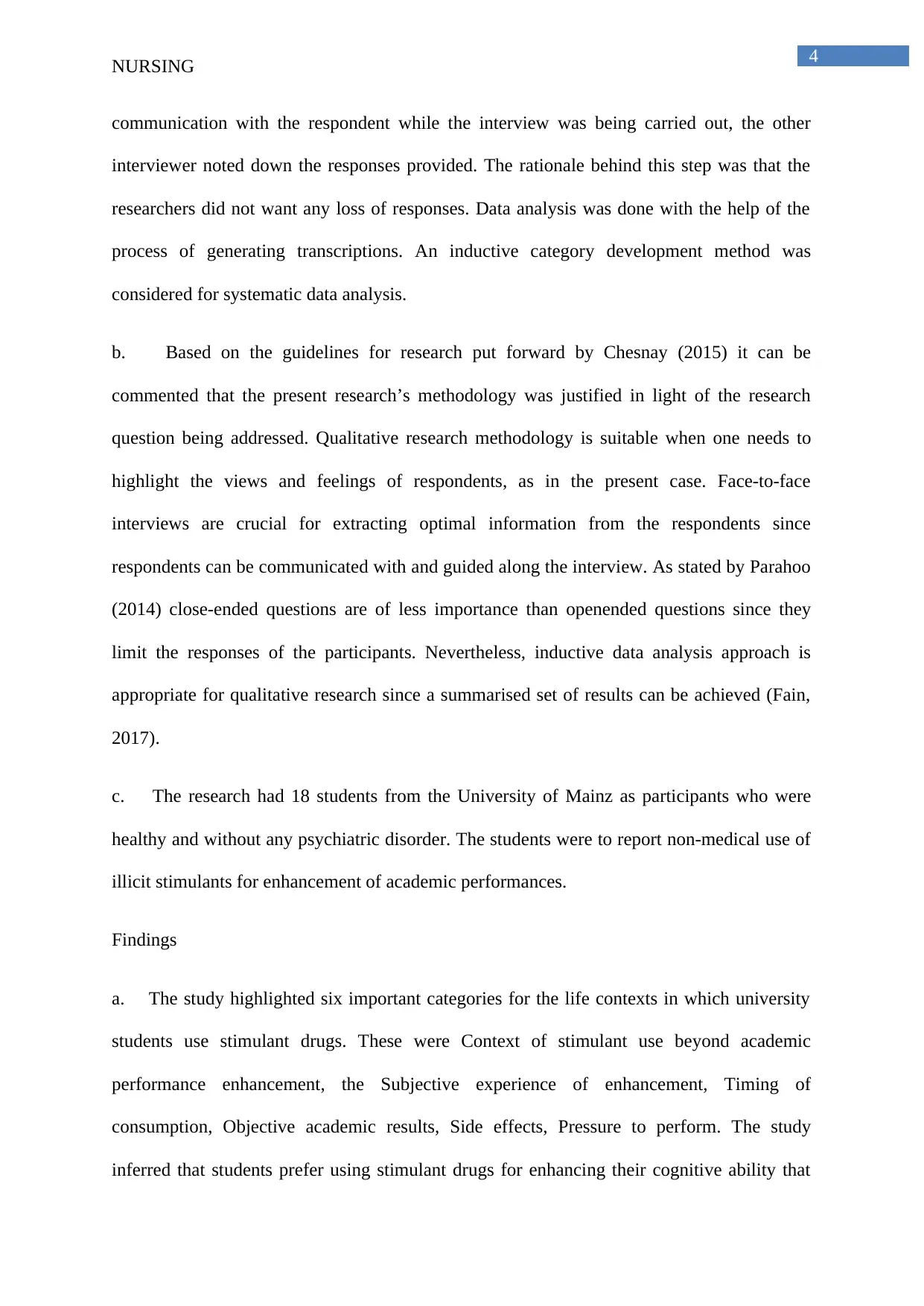
4
NURSING
communication with the respondent while the interview was being carried out, the other
interviewer noted down the responses provided. The rationale behind this step was that the
researchers did not want any loss of responses. Data analysis was done with the help of the
process of generating transcriptions. An inductive category development method was
considered for systematic data analysis.
b. Based on the guidelines for research put forward by Chesnay (2015) it can be
commented that the present research’s methodology was justified in light of the research
question being addressed. Qualitative research methodology is suitable when one needs to
highlight the views and feelings of respondents, as in the present case. Face-to-face
interviews are crucial for extracting optimal information from the respondents since
respondents can be communicated with and guided along the interview. As stated by Parahoo
(2014) close-ended questions are of less importance than openended questions since they
limit the responses of the participants. Nevertheless, inductive data analysis approach is
appropriate for qualitative research since a summarised set of results can be achieved (Fain,
2017).
c. The research had 18 students from the University of Mainz as participants who were
healthy and without any psychiatric disorder. The students were to report non-medical use of
illicit stimulants for enhancement of academic performances.
Findings
a. The study highlighted six important categories for the life contexts in which university
students use stimulant drugs. These were Context of stimulant use beyond academic
performance enhancement, the Subjective experience of enhancement, Timing of
consumption, Objective academic results, Side effects, Pressure to perform. The study
inferred that students prefer using stimulant drugs for enhancing their cognitive ability that
NURSING
communication with the respondent while the interview was being carried out, the other
interviewer noted down the responses provided. The rationale behind this step was that the
researchers did not want any loss of responses. Data analysis was done with the help of the
process of generating transcriptions. An inductive category development method was
considered for systematic data analysis.
b. Based on the guidelines for research put forward by Chesnay (2015) it can be
commented that the present research’s methodology was justified in light of the research
question being addressed. Qualitative research methodology is suitable when one needs to
highlight the views and feelings of respondents, as in the present case. Face-to-face
interviews are crucial for extracting optimal information from the respondents since
respondents can be communicated with and guided along the interview. As stated by Parahoo
(2014) close-ended questions are of less importance than openended questions since they
limit the responses of the participants. Nevertheless, inductive data analysis approach is
appropriate for qualitative research since a summarised set of results can be achieved (Fain,
2017).
c. The research had 18 students from the University of Mainz as participants who were
healthy and without any psychiatric disorder. The students were to report non-medical use of
illicit stimulants for enhancement of academic performances.
Findings
a. The study highlighted six important categories for the life contexts in which university
students use stimulant drugs. These were Context of stimulant use beyond academic
performance enhancement, the Subjective experience of enhancement, Timing of
consumption, Objective academic results, Side effects, Pressure to perform. The study
inferred that students prefer using stimulant drugs for enhancing their cognitive ability that
Paraphrase This Document
Need a fresh take? Get an instant paraphrase of this document with our AI Paraphraser
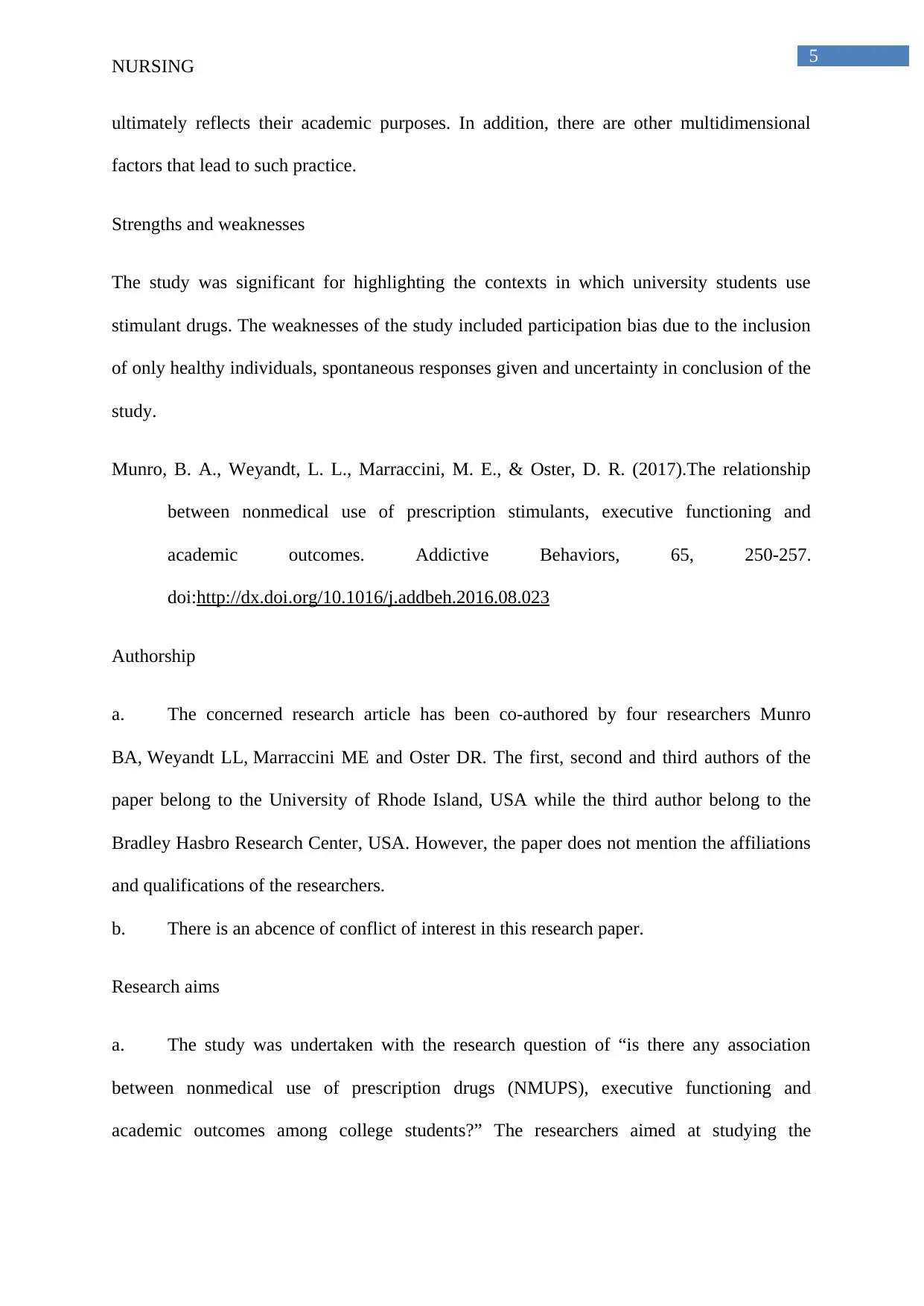
5
NURSING
ultimately reflects their academic purposes. In addition, there are other multidimensional
factors that lead to such practice.
Strengths and weaknesses
The study was significant for highlighting the contexts in which university students use
stimulant drugs. The weaknesses of the study included participation bias due to the inclusion
of only healthy individuals, spontaneous responses given and uncertainty in conclusion of the
study.
Munro, B. A., Weyandt, L. L., Marraccini, M. E., & Oster, D. R. (2017).The relationship
between nonmedical use of prescription stimulants, executive functioning and
academic outcomes. Addictive Behaviors, 65, 250-257.
doi:http://dx.doi.org/10.1016/j.addbeh.2016.08.023
Authorship
a. The concerned research article has been co-authored by four researchers Munro
BA, Weyandt LL, Marraccini ME and Oster DR. The first, second and third authors of the
paper belong to the University of Rhode Island, USA while the third author belong to the
Bradley Hasbro Research Center, USA. However, the paper does not mention the affiliations
and qualifications of the researchers.
b. There is an abcence of conflict of interest in this research paper.
Research aims
a. The study was undertaken with the research question of “is there any association
between nonmedical use of prescription drugs (NMUPS), executive functioning and
academic outcomes among college students?” The researchers aimed at studying the
NURSING
ultimately reflects their academic purposes. In addition, there are other multidimensional
factors that lead to such practice.
Strengths and weaknesses
The study was significant for highlighting the contexts in which university students use
stimulant drugs. The weaknesses of the study included participation bias due to the inclusion
of only healthy individuals, spontaneous responses given and uncertainty in conclusion of the
study.
Munro, B. A., Weyandt, L. L., Marraccini, M. E., & Oster, D. R. (2017).The relationship
between nonmedical use of prescription stimulants, executive functioning and
academic outcomes. Addictive Behaviors, 65, 250-257.
doi:http://dx.doi.org/10.1016/j.addbeh.2016.08.023
Authorship
a. The concerned research article has been co-authored by four researchers Munro
BA, Weyandt LL, Marraccini ME and Oster DR. The first, second and third authors of the
paper belong to the University of Rhode Island, USA while the third author belong to the
Bradley Hasbro Research Center, USA. However, the paper does not mention the affiliations
and qualifications of the researchers.
b. There is an abcence of conflict of interest in this research paper.
Research aims
a. The study was undertaken with the research question of “is there any association
between nonmedical use of prescription drugs (NMUPS), executive functioning and
academic outcomes among college students?” The researchers aimed at studying the
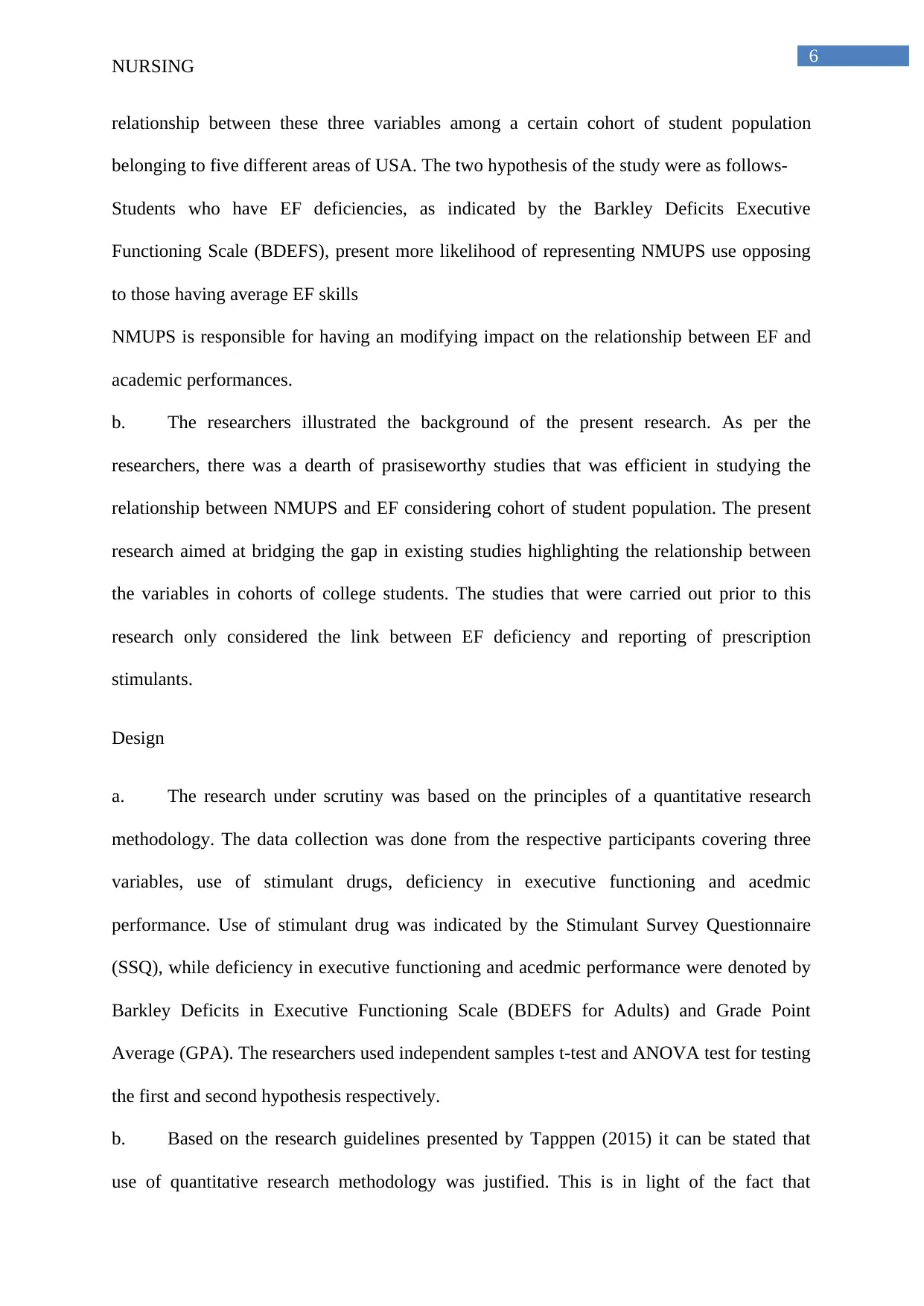
6
NURSING
relationship between these three variables among a certain cohort of student population
belonging to five different areas of USA. The two hypothesis of the study were as follows-
Students who have EF deficiencies, as indicated by the Barkley Deficits Executive
Functioning Scale (BDEFS), present more likelihood of representing NMUPS use opposing
to those having average EF skills
NMUPS is responsible for having an modifying impact on the relationship between EF and
academic performances.
b. The researchers illustrated the background of the present research. As per the
researchers, there was a dearth of prasiseworthy studies that was efficient in studying the
relationship between NMUPS and EF considering cohort of student population. The present
research aimed at bridging the gap in existing studies highlighting the relationship between
the variables in cohorts of college students. The studies that were carried out prior to this
research only considered the link between EF deficiency and reporting of prescription
stimulants.
Design
a. The research under scrutiny was based on the principles of a quantitative research
methodology. The data collection was done from the respective participants covering three
variables, use of stimulant drugs, deficiency in executive functioning and acedmic
performance. Use of stimulant drug was indicated by the Stimulant Survey Questionnaire
(SSQ), while deficiency in executive functioning and acedmic performance were denoted by
Barkley Deficits in Executive Functioning Scale (BDEFS for Adults) and Grade Point
Average (GPA). The researchers used independent samples t-test and ANOVA test for testing
the first and second hypothesis respectively.
b. Based on the research guidelines presented by Tapppen (2015) it can be stated that
use of quantitative research methodology was justified. This is in light of the fact that
NURSING
relationship between these three variables among a certain cohort of student population
belonging to five different areas of USA. The two hypothesis of the study were as follows-
Students who have EF deficiencies, as indicated by the Barkley Deficits Executive
Functioning Scale (BDEFS), present more likelihood of representing NMUPS use opposing
to those having average EF skills
NMUPS is responsible for having an modifying impact on the relationship between EF and
academic performances.
b. The researchers illustrated the background of the present research. As per the
researchers, there was a dearth of prasiseworthy studies that was efficient in studying the
relationship between NMUPS and EF considering cohort of student population. The present
research aimed at bridging the gap in existing studies highlighting the relationship between
the variables in cohorts of college students. The studies that were carried out prior to this
research only considered the link between EF deficiency and reporting of prescription
stimulants.
Design
a. The research under scrutiny was based on the principles of a quantitative research
methodology. The data collection was done from the respective participants covering three
variables, use of stimulant drugs, deficiency in executive functioning and acedmic
performance. Use of stimulant drug was indicated by the Stimulant Survey Questionnaire
(SSQ), while deficiency in executive functioning and acedmic performance were denoted by
Barkley Deficits in Executive Functioning Scale (BDEFS for Adults) and Grade Point
Average (GPA). The researchers used independent samples t-test and ANOVA test for testing
the first and second hypothesis respectively.
b. Based on the research guidelines presented by Tapppen (2015) it can be stated that
use of quantitative research methodology was justified. This is in light of the fact that
⊘ This is a preview!⊘
Do you want full access?
Subscribe today to unlock all pages.

Trusted by 1+ million students worldwide
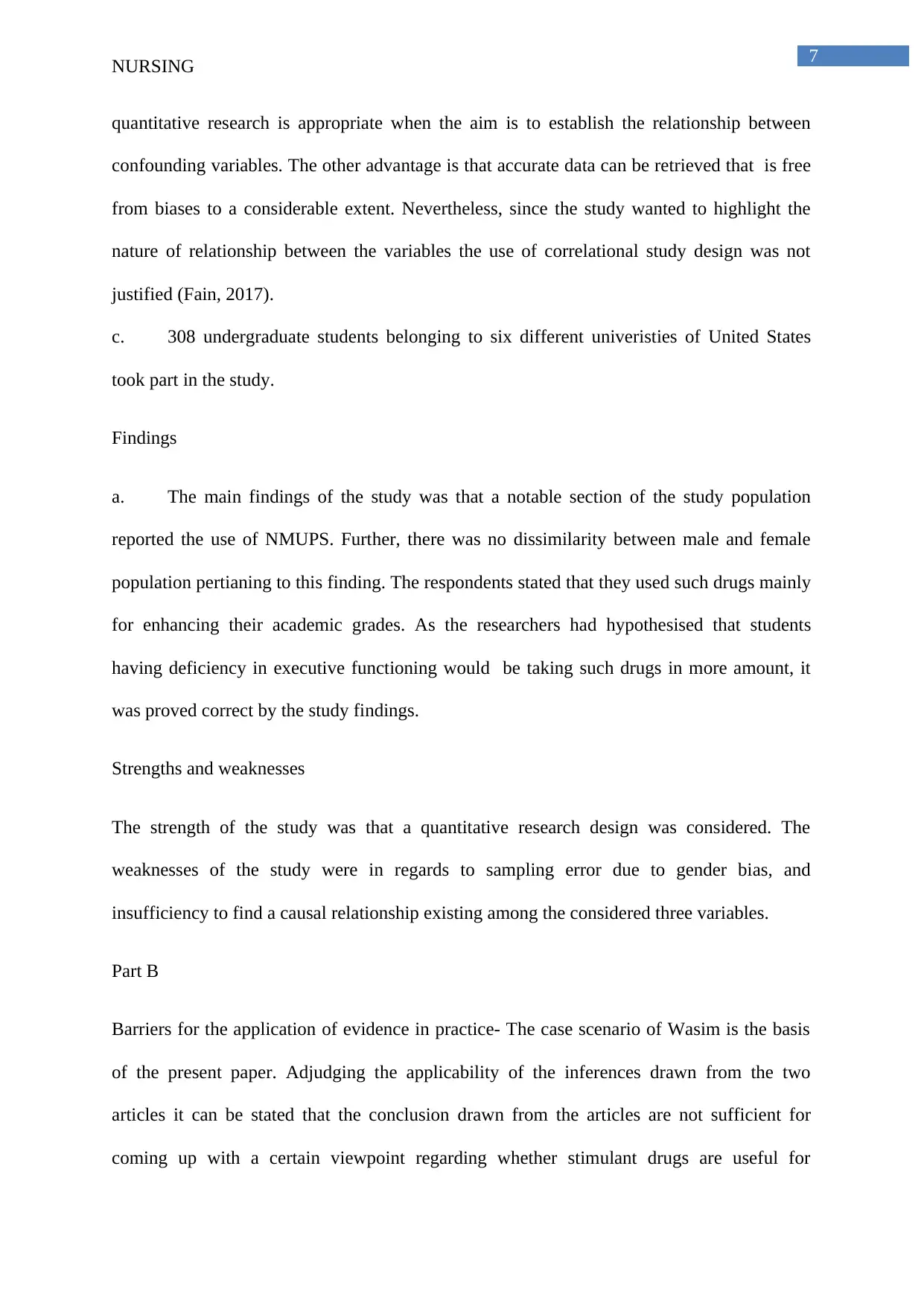
7
NURSING
quantitative research is appropriate when the aim is to establish the relationship between
confounding variables. The other advantage is that accurate data can be retrieved that is free
from biases to a considerable extent. Nevertheless, since the study wanted to highlight the
nature of relationship between the variables the use of correlational study design was not
justified (Fain, 2017).
c. 308 undergraduate students belonging to six different univeristies of United States
took part in the study.
Findings
a. The main findings of the study was that a notable section of the study population
reported the use of NMUPS. Further, there was no dissimilarity between male and female
population pertianing to this finding. The respondents stated that they used such drugs mainly
for enhancing their academic grades. As the researchers had hypothesised that students
having deficiency in executive functioning would be taking such drugs in more amount, it
was proved correct by the study findings.
Strengths and weaknesses
The strength of the study was that a quantitative research design was considered. The
weaknesses of the study were in regards to sampling error due to gender bias, and
insufficiency to find a causal relationship existing among the considered three variables.
Part B
Barriers for the application of evidence in practice- The case scenario of Wasim is the basis
of the present paper. Adjudging the applicability of the inferences drawn from the two
articles it can be stated that the conclusion drawn from the articles are not sufficient for
coming up with a certain viewpoint regarding whether stimulant drugs are useful for
NURSING
quantitative research is appropriate when the aim is to establish the relationship between
confounding variables. The other advantage is that accurate data can be retrieved that is free
from biases to a considerable extent. Nevertheless, since the study wanted to highlight the
nature of relationship between the variables the use of correlational study design was not
justified (Fain, 2017).
c. 308 undergraduate students belonging to six different univeristies of United States
took part in the study.
Findings
a. The main findings of the study was that a notable section of the study population
reported the use of NMUPS. Further, there was no dissimilarity between male and female
population pertianing to this finding. The respondents stated that they used such drugs mainly
for enhancing their academic grades. As the researchers had hypothesised that students
having deficiency in executive functioning would be taking such drugs in more amount, it
was proved correct by the study findings.
Strengths and weaknesses
The strength of the study was that a quantitative research design was considered. The
weaknesses of the study were in regards to sampling error due to gender bias, and
insufficiency to find a causal relationship existing among the considered three variables.
Part B
Barriers for the application of evidence in practice- The case scenario of Wasim is the basis
of the present paper. Adjudging the applicability of the inferences drawn from the two
articles it can be stated that the conclusion drawn from the articles are not sufficient for
coming up with a certain viewpoint regarding whether stimulant drugs are useful for
Paraphrase This Document
Need a fresh take? Get an instant paraphrase of this document with our AI Paraphraser
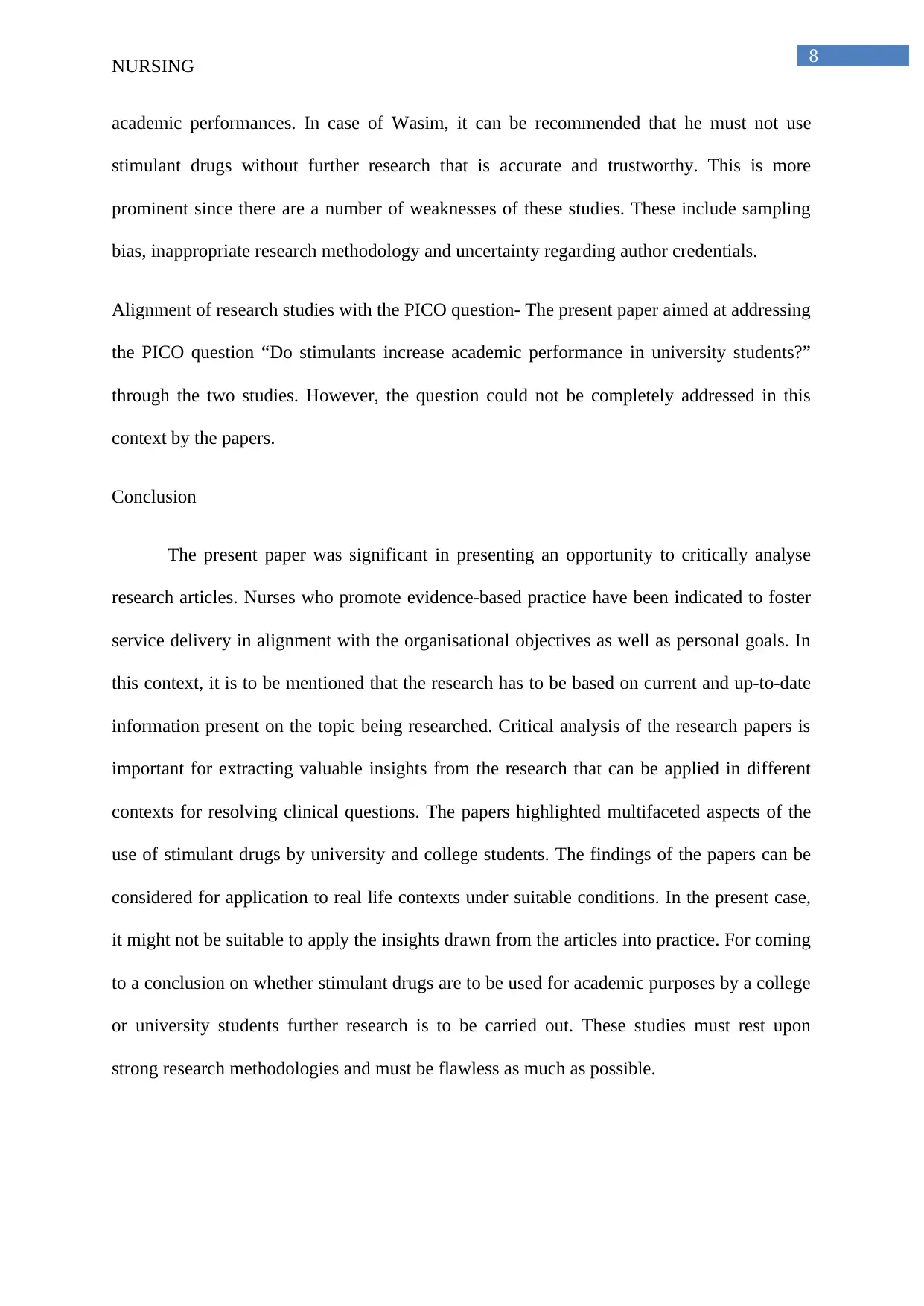
8
NURSING
academic performances. In case of Wasim, it can be recommended that he must not use
stimulant drugs without further research that is accurate and trustworthy. This is more
prominent since there are a number of weaknesses of these studies. These include sampling
bias, inappropriate research methodology and uncertainty regarding author credentials.
Alignment of research studies with the PICO question- The present paper aimed at addressing
the PICO question “Do stimulants increase academic performance in university students?”
through the two studies. However, the question could not be completely addressed in this
context by the papers.
Conclusion
The present paper was significant in presenting an opportunity to critically analyse
research articles. Nurses who promote evidence-based practice have been indicated to foster
service delivery in alignment with the organisational objectives as well as personal goals. In
this context, it is to be mentioned that the research has to be based on current and up-to-date
information present on the topic being researched. Critical analysis of the research papers is
important for extracting valuable insights from the research that can be applied in different
contexts for resolving clinical questions. The papers highlighted multifaceted aspects of the
use of stimulant drugs by university and college students. The findings of the papers can be
considered for application to real life contexts under suitable conditions. In the present case,
it might not be suitable to apply the insights drawn from the articles into practice. For coming
to a conclusion on whether stimulant drugs are to be used for academic purposes by a college
or university students further research is to be carried out. These studies must rest upon
strong research methodologies and must be flawless as much as possible.
NURSING
academic performances. In case of Wasim, it can be recommended that he must not use
stimulant drugs without further research that is accurate and trustworthy. This is more
prominent since there are a number of weaknesses of these studies. These include sampling
bias, inappropriate research methodology and uncertainty regarding author credentials.
Alignment of research studies with the PICO question- The present paper aimed at addressing
the PICO question “Do stimulants increase academic performance in university students?”
through the two studies. However, the question could not be completely addressed in this
context by the papers.
Conclusion
The present paper was significant in presenting an opportunity to critically analyse
research articles. Nurses who promote evidence-based practice have been indicated to foster
service delivery in alignment with the organisational objectives as well as personal goals. In
this context, it is to be mentioned that the research has to be based on current and up-to-date
information present on the topic being researched. Critical analysis of the research papers is
important for extracting valuable insights from the research that can be applied in different
contexts for resolving clinical questions. The papers highlighted multifaceted aspects of the
use of stimulant drugs by university and college students. The findings of the papers can be
considered for application to real life contexts under suitable conditions. In the present case,
it might not be suitable to apply the insights drawn from the articles into practice. For coming
to a conclusion on whether stimulant drugs are to be used for academic purposes by a college
or university students further research is to be carried out. These studies must rest upon
strong research methodologies and must be flawless as much as possible.
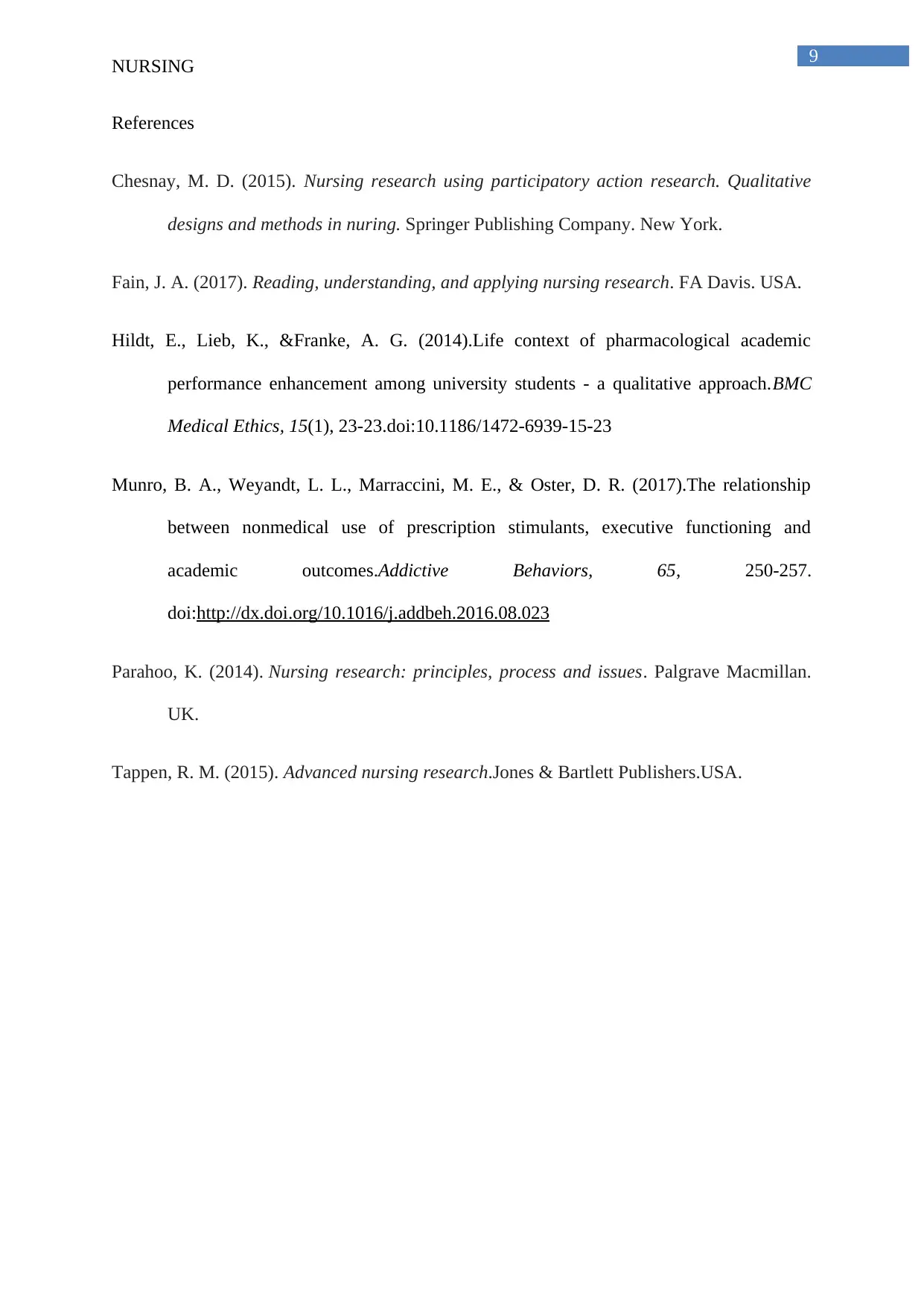
9
NURSING
References
Chesnay, M. D. (2015). Nursing research using participatory action research. Qualitative
designs and methods in nuring. Springer Publishing Company. New York.
Fain, J. A. (2017). Reading, understanding, and applying nursing research. FA Davis. USA.
Hildt, E., Lieb, K., &Franke, A. G. (2014).Life context of pharmacological academic
performance enhancement among university students - a qualitative approach.BMC
Medical Ethics, 15(1), 23-23.doi:10.1186/1472-6939-15-23
Munro, B. A., Weyandt, L. L., Marraccini, M. E., & Oster, D. R. (2017).The relationship
between nonmedical use of prescription stimulants, executive functioning and
academic outcomes.Addictive Behaviors, 65, 250-257.
doi:http://dx.doi.org/10.1016/j.addbeh.2016.08.023
Parahoo, K. (2014). Nursing research: principles, process and issues. Palgrave Macmillan.
UK.
Tappen, R. M. (2015). Advanced nursing research.Jones & Bartlett Publishers.USA.
NURSING
References
Chesnay, M. D. (2015). Nursing research using participatory action research. Qualitative
designs and methods in nuring. Springer Publishing Company. New York.
Fain, J. A. (2017). Reading, understanding, and applying nursing research. FA Davis. USA.
Hildt, E., Lieb, K., &Franke, A. G. (2014).Life context of pharmacological academic
performance enhancement among university students - a qualitative approach.BMC
Medical Ethics, 15(1), 23-23.doi:10.1186/1472-6939-15-23
Munro, B. A., Weyandt, L. L., Marraccini, M. E., & Oster, D. R. (2017).The relationship
between nonmedical use of prescription stimulants, executive functioning and
academic outcomes.Addictive Behaviors, 65, 250-257.
doi:http://dx.doi.org/10.1016/j.addbeh.2016.08.023
Parahoo, K. (2014). Nursing research: principles, process and issues. Palgrave Macmillan.
UK.
Tappen, R. M. (2015). Advanced nursing research.Jones & Bartlett Publishers.USA.
⊘ This is a preview!⊘
Do you want full access?
Subscribe today to unlock all pages.

Trusted by 1+ million students worldwide
1 out of 9
Related Documents
Your All-in-One AI-Powered Toolkit for Academic Success.
+13062052269
info@desklib.com
Available 24*7 on WhatsApp / Email
![[object Object]](/_next/static/media/star-bottom.7253800d.svg)
Unlock your academic potential
Copyright © 2020–2025 A2Z Services. All Rights Reserved. Developed and managed by ZUCOL.





